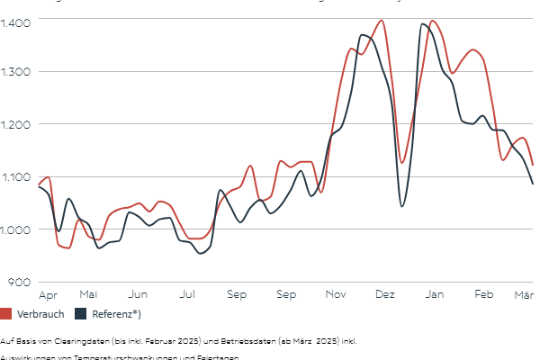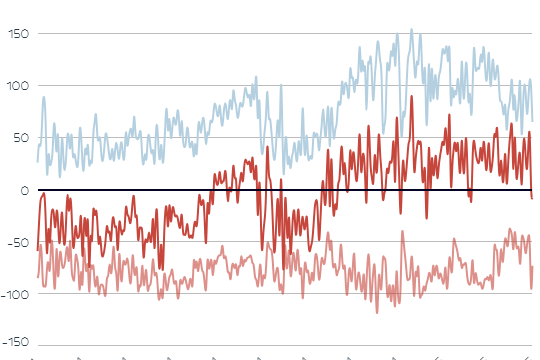Austria is an electricity-importing country for the fifth time in a row in March
The APG factbox shows a significant year-on-year decline in renewable production of almost a third in March. Under these circumstances, Austria was again an electricity importer on balance, just like in the previous four months.
In concrete terms, Austria (APG control area*) could export electricity only on a single day in March, while, on balance, imports amounted to 927 GWh over the entire month (based on the schedules). In contrast, Austria exported electricity on 19 days in March 2024, achieving a net export volume of 158 GWh (based on the schedules). The main reason for this can be seen in the exceptionally good run-of-river feed-in in spring 2024 compared to the long-term average.
"In 2024, the low water flow and the lack of wind could also be compensated for by the expansion of PV generation by almost 2,000 MW," explains APG’s CTO Gerhard Christiner.
Decline in renewable generation
As in February, March 2025 saw a clear year-on-year decline in renewable generation. Specifically, the feed-in of renewable energy in March (calendar weeks 10-13) fell by around a third (30.9%) compared to the previous year. Even though the month can be described as quite rainy in retrospect, there were significant differences in the regional distribution of precipitation across Austria.
In this context, hydropower still accounted for the largest share of renewable generation at 1,560 GWh, even though its contribution decreased by 10% compared to the previous year. Wind energy contributed 753 GWh (plus 3% share of renewables compared to March 2024) to the generation of sustainable electricity, while the PV feed-in amounted to 417 GWh (plus 5%).
The share of renewable energies (2,913 GWh) in Austria's electricity consumption (4,587 GWh) was around 63.5%.
Multiple challenges show the importance of a high-capacity electricity infrastructure
March highlighted the complexity and volatility of the entire electricity system in Austria: The domestic electricity consumption was once again high. At the same time, the dynamics of the energy industry, in particular, the declines in renewable production shares, clearly emphasized the volatility that an overall electricity system based on renewable energies is confronted with. Deficits in the grid infrastructure had to be compensated for or cushioned by various bridging measures. Also in March, APG had to resort to the targeted use of thermal or hydraulic power plants and the curtailment of renewable facilities to prevent grid overloads.
"In addition to extensive electricity imports from the European internal market to cover the electricity demand in Austria, the operation of thermal power plants as grid reserve to secure the domestic electricity supply and to avert grid bottlenecks was indispensable also in March. These developments once again underline the urgency of a careful and forward-looking expansion to establish a high-capacity and secure electricity grid," says Christiner.
In March 2025, interventions in the schedule of power plants in Austria were necessary on 16 days to avoid overloads of the grid. This is 3 days more than in March 2024. These interventions cause costs that eventually have to be borne by the electricity customers. In March 2025, these costs totaled approximately 4.1 million euros, costs that reflect the lack of grid capacities.
A negative effect in addition to the costs and rising CO2 consumption is the "curtailment" of renewable power plant production: For example, wind power plants or run-of-river power plants that would be producing electricity at a certain time are shut down to avoid overloads in the electricity grid. Since the beginning of the year, around 1,907 megawatt hours (MWh) of electricity have been "lost" due to these redispatch measures.
These figures illustrate the need for a modern, resilient, overall energy system with, above all, a high-capacity transmission grid infrastructure.
Energy exchange within Austria
The exchange of energy across Austria is managed via APG’s transmission grid. Electricity surpluses in individual provinces can thus be distributed throughout Austria to compensate for deficits.
In March, Burgenland (231 GWh) and Lower Austria (189 GWh) fed the highest volumes of energy into the APG grid and thus made it available throughout Austria. Tyrol (214 GWh) and Styria (210 GWh) drew the most electricity from the APG grid.
Responsible electricity consumption
The latest available data show that 4,587 GWh of electricity were consumed from the public grid in Austria in March (calendar weeks 10-13) - around 0.5 percent more than in March 2024 (4,565 GWh). This is the electricity drawn from the public grid in the APG control area. The figures do not include electricity produced and consumed by private PV units.
Tips for saving electricity can be found at www.apg.at/stromspartipps. With the APG Powermonitor, the Austrian population can see the most effective electricity-saving hours and thus make an active contribution to CO2 reduction and system security. The APG Powermonitor can be found at www.apg.at/powermonitor.
APG continually keeps track of the development of the domestic electricity industry and regularly publishes diagrams at https://www.apg.at/infografiken regarding the topics: energy exchange, energy consumption in Austria, renewables production, import/export, electricity prices, etc.
* The APG control area comprises almost all of Austria with the exception of a corridor each in Vorarlberg and Tyrol.
About Austrian Power Grid (APG)
As independent transmission system operator, Austrian Power Grid (APG) is in charge of ensuring the security of the electricity supply in Austria. With our high-performance and digital electricity infrastructure and the use of state-of-the-art technologies we integrate renewable energies and reduce the dependency on electricity imports, we are the platform for the electricity market, and we provide access to reasonably priced electricity and thus create the basis for Austria as supply-secure and future-oriented industrial and business location and place to live. The APG grid totals a length of about 3,500 km and is operated, maintained, and continuously adapted to the increasing challenges of the electrification of businesses, industry, and society by a team of approximately 1,000 specialists. 67 substations are distributed all over Austria, and the majority is operated remotely. Thanks to our committed employees, Austria had a security of supply of 99.99 percent also in 2024 and thus ranks among the top countries worldwide. Our investments of 630 million euros in 2025 (2024: 440 million euros, 2023: 490 million euros) are a motor for the Austrian economy and a crucial factor for a secure energy transition.
Press contact
Christoph Schuh




